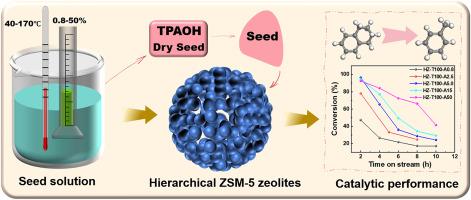调节种子溶液辅助合成分级ZSM-5沸石以促进四氢化萘的高效裂解
IF 4.7
3区 材料科学
Q1 CHEMISTRY, APPLIED
引用次数: 0
摘要
开发无介孔合成ZSM-5分子筛的工艺路线对于推进其在重油裂解等扩散受限催化过程中的应用至关重要。在这里,我们通过协同控制种子溶液温度(70-170°C)和添加量(0.8-50 wt%)来开发无介孔激素策略。采用x射线衍射(XRD)、扫描电镜(SEM)、透射电镜(TEM)、氮气吸附-解吸、氨程序升温解吸(NH3-TPD)、吡啶红外(Py-IR)等技术对合成的沸石进行了表征。结果表明,样品中孔丰富,微孔保存完好。为了突出种子溶液的关键作用,在相当于种子溶液添加量的TPAOH条件下和相当于种子溶液的室温干燥种子固体条件下进行了对照实验。值得注意的是,储存三个月的种子溶液在合成相纯ZSM-5沸石时仍然有效,表现出优异的稳定性。在四氢萘(重油模型)裂解试验中,优化后的沸石(HZ-T100-A50)在2 h内转化率达到90%,比HZ-T100-A0.8提高了20%,这主要归功于反应物可及性的提高。本研究不仅为无介孔模板的ZSM-5分子筛层次化合成提供了一种生态友好的方法,而且加深了对种子溶液影响的认识,为优化分子筛的合成和应用提供了重要依据。本文章由计算机程序翻译,如有差异,请以英文原文为准。

Adjusting seed solution-assisted synthesis of hierarchical ZSM-5 zeolite to facilitate efficient tetralin cracking
The development of mesoporogen-free synthetic routes for hierarchical ZSM-5 zeolites is critical to advancing their application in diffusion-constrained catalytic processes such as heavy oil cracking. Here, we develop a mesoporogen-free strategy through synergistic control of seed solution temperature (70–170 °C) and addition amount (0.8–50 wt%). The synthesized zeolites were characterized using techniques such as X-ray Diffraction (XRD), Scanning electron microscope (SEM), Transmission electron microscopy (TEM), N2 adsorption-desorption, ammonia temperature-programmed desorption (NH3-TPD), and pyridine-infrared (Py-IR). The results show that the sample is rich in mesopores and has well-preserved microporosity. Control experiments under TPAOH conditions equivalent to the seed solution addition amounts and with room-temperature-dried seed solids equivalent to the seed solution were conducted to highlight the critical role of seed solutions. Notably, seed solutions stored for three months retained their effectiveness in synthesizing phase-pure ZSM-5 zeolites, demonstrating exceptional stability. In tetralin (heavy oil model) cracking tests, the optimized zeolite (HZ-T100-A50) achieved 90 % conversion within 2 h, which is 20 % higher than HZ-T100-A0.8, attributed to enhanced reactant accessibility. This study not only provides an eco-friendly method for synthesizing hierarchical ZSM-5 zeolites without mesoporous templates but also deepens the understanding of seed solution impacts, offering an important basis for optimizing zeolites synthesis and application.
求助全文
通过发布文献求助,成功后即可免费获取论文全文。
去求助
来源期刊

Microporous and Mesoporous Materials
化学-材料科学:综合
CiteScore
10.70
自引率
5.80%
发文量
649
审稿时长
26 days
期刊介绍:
Microporous and Mesoporous Materials covers novel and significant aspects of porous solids classified as either microporous (pore size up to 2 nm) or mesoporous (pore size 2 to 50 nm). The porosity should have a specific impact on the material properties or application. Typical examples are zeolites and zeolite-like materials, pillared materials, clathrasils and clathrates, carbon molecular sieves, ordered mesoporous materials, organic/inorganic porous hybrid materials, or porous metal oxides. Both natural and synthetic porous materials are within the scope of the journal.
Topics which are particularly of interest include:
All aspects of natural microporous and mesoporous solids
The synthesis of crystalline or amorphous porous materials
The physico-chemical characterization of microporous and mesoporous solids, especially spectroscopic and microscopic
The modification of microporous and mesoporous solids, for example by ion exchange or solid-state reactions
All topics related to diffusion of mobile species in the pores of microporous and mesoporous materials
Adsorption (and other separation techniques) using microporous or mesoporous adsorbents
Catalysis by microporous and mesoporous materials
Host/guest interactions
Theoretical chemistry and modelling of host/guest interactions
All topics related to the application of microporous and mesoporous materials in industrial catalysis, separation technology, environmental protection, electrochemistry, membranes, sensors, optical devices, etc.
 求助内容:
求助内容: 应助结果提醒方式:
应助结果提醒方式:


